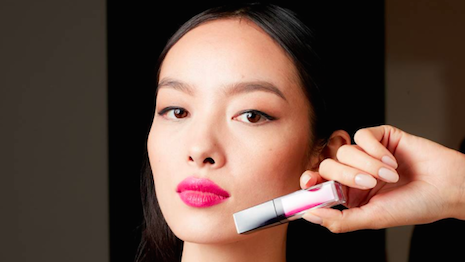China’s beauty market is dominated by mass-market players, but luxury brands are embracing technology and personalization to propel their growth at a faster rate.
According to a new report from J.P. Morgan, China is the world’s second largest beauty market and sales there jumped almost 13 percent in 2018. Luxury labels including Estée Lauder have also benefitted the most from the boom in ecommerce beauty sales.
“Younger Chinese consumers are not only more affluent, they are also using skincare much earlier than previous generations,” said Andrea Teixeira, head of North America beverage, household and personal care research at J.P. Morgan, New York. “Alibaba and other ecommerce platforms have accelerated this process, particularly for luxury cosmetics, and now represent more than 30 percent of premium cosmetics sales in China.”
Luxury beauty
Worldwide, the beauty industry has seen rapid growth due to the popularity of ecommerce and social media – including “selfie culture” and viral online beauty tutorials.
China now accounts for 14 percent of the global beauty market, up from 12 percent in 2013. The country’s beauty market grew 12.9 percent in 2018, compared to growth of 4.6 percent in the United States, the world’s largest beauty market.
While luxury products only account for about a third of beauty sales in China, these brands have grown at a faster pace than mass-market beauty. Beauty group L’Oréal has a 17 percent share in China, followed by Estée Lauder with 13 percent and Shiseido at 6 percent.
Skincare is the strongest beauty category worldwide with sales of more than $104 billion in 2018 representing a growth of 7.6 percent, outpacing hair care, cosmetics and fragrances. In China, this has further boosted sales for L’Oréal and Estée Lauder.
L’Oréal’s sales were up 11.4 percent in the first quarter of the year, propelled partly by double-digit growth in its luxury division. While almost all regions recorded growth, Asia Pacific saw the strongest increase with a 30.4 percent bump in sales (see story).
Estée Lauder Companies’ sales increased 9 percent year-over-year in the 2019 fiscal year. Along with its star brands of Estée Lauder, La Mer and Tom Ford Beauty, the group’s growth was attributed to skincare and demand in Asia Pacific, including China (see story).
Meanwhile, Japanese beauty group Shiseido is acquiring skincare company Drunk Elephant as it looks to become more competitive in this space with younger consumers (see story).
These global beauty groups have an advantage in skincare because they have the resources to devote to the research and development of these products. Although ecommerce has allowed smaller beauty brands to emerge, it is harder for indie labels to challenge luxury players in skincare.
“This growth in ecommerce in China has really favored the development of luxury brands by creating a new point of distribution, well ahead of any developments seen in department stores,” said Celine Pannuti, head of European consumer goods research at J.P. Morgan, London. “Young customers with real spending power, often subsidized by their parents and grandparents, set the Chinese market apart.”
Tech in beauty
Luxury beauty groups also have the means to invest in technology, including artificial intelligence and augmented reality, allowing beauty shopping to become more personalized – even through ecommerce.
“With the millennial generation getting older and makeup serving as a recruitment tool for skincare, we believe the accelerating growth trend in prestige skin care is here to stay longer-term,” J.P. Morgan’s Ms. Teixeira said. “We see this as a great opportunity for pure prestige players.”
Since this summer, L’Oréal’s AR makeup platform ModiFace supports Armani Beauty’s virtual makeup application on WeChat, one of the leading social media platforms in China.
Armani Beauty’s AR try-on is meant to mimic the virtual mirrors that are becoming more commonplace in Chinese bricks-and-mortar stores.
Users can virtually sample Armani products, such as lip colors, with the shades remaining consistent as consumers pose in front of their smartphone cameras. The app also allows users to take screenshots, save images, compare before and after images in a split-screen mode and share on social media – a popular activity among Chinese millennials (see story).
Shiseido is also using technology to deliver tailored skincare to consumers through a brand that is solely available via subscription.
Dubbed Optune, the brand’s skincare system is powered by a mobile application, which analyzes a consumer’s skin and the conditions in his or her area to blend customized products. Playing into the growing subscription beauty business, Optune will be sold on a monthly basis (see story).
“At the heart of it, the beauty industry is a business of personal advice, and technology is just enabling this,” J.P. Morgan’s Ms. Pannuti said. “So what you see from tutorials to targeted content, augmented reality or even personalization of products – all enabled by digitalization – has really been an accelerator for the industry.”
{"ct":"l80FPfSzkj8RH+7yiv62LjwMzg\/tFGuXhSWOvtP7i2aJ3IXtYs0BSn+W+ykDb8O\/EI40AXsLnLr\/wseNtfJsOVMYSl36w8wdSe22hCx1hRf8X452iMtJWFugHG+fvJCmSP8fwgKhKow2Doezd\/rsxZRDJqHlQTTwpZgKmr3IzrElSqg7KqJGify\/QhqkNbXmZMSV1kA4lopH2eOMrM33i1KTw3mwwhOlN251GbryVk70+he6e\/hJN8NdEIbjRECqIzPSMa9AsyPoFWy+POyIcYJOdAn0GJ5xFB2a6h9L09uKRO0TXe7Mri4A16ffmTsTyaHcMMP+Zqs8PrkQndk4J1R25mh+y3P2CAcUxgofhwyiJUCi9c46CZWWzt5oOA4hIflfAVjN1E49xRY9lv\/FWtDz42PnjJgs4FHPwvtyAcDdIhgahljcW5ZPrYQsONWM\/7ql067VQycXdi7cw6hspD7eI\/0eILQJdJkjAsiQ9adofA34qwHvILfH39w4Ad4xu5x17uQFcHa2B5CEa9drJ3H3y2htdq1PgvQjrmFt8OAdWxtBU\/p3Frhm8DP3hWqY\/K8BBr3am\/SGmLuVu6\/MHo0+iyuyAJ4pW0BquGTb5ElpOLPSohkGP+PXDmVA5hu0zwS7wKoALpzvH8Os8gEtEtTBSK\/r6zoU7730fSWt1\/UZy0n1fawbJJH2CDKSTVtQYidgGGvUPGUpEFO3+dtdkf02ODJZg4tXFYPP\/vdtPAXkzW7CK7YuwwrQ9ZKwmlZ0tpSeOowyOlths+aO3px0PUuOG6V0KSyOMiYw529cONMoUqp3y4zYnOtjpkkJDHTEegMFS8Lz8QMy51aHwTJJ6hzMQbXHQjUc9yFB53QhQtm\/mshY89NkqSzpCTPL7xtaRET9ny+w1rLeHNI1JM91Zkwf1ijvPdG4JyA8IQl91oQIf45LNXxPkORzBpJw4KxW3myIrryqaUaPECP+1kTUGv6nFEE1RQeIlsM\/xEV+st5WbxweFB28OfSME5mXhWqfV1wwrwqaUw14nUE+ERHzUlCkP+aRMyY4sz2vB9qHliUhWavLpfXAhRMBU7uDdB7LFOOcnd8d55wePxnA2mkROE6ekS1KMTWHA5cR3y1BSFjMAGXw5e3wpncVpfC5yDza9aEyP9YU3uCV+10u5mraYhZAkHg7Y5F6ruckeBmVlaDmMmUlBgwX5CRIAFMr8kBbuO6Dq16ccw+B1kLIC6i1lRqcJJFaSVe2bINOTso+Z6bCodK99cpw9fcFuYVJ99NyJ6QZrJ1d3PK\/gn+svESi8uVW7edVx7GeOOvns5N03CyKt7zqzPAGychTaRLE3asR8cpXoHbE\/KpZbCJWQXDE+bsz83DyxKJW8Lx+GpmQrNWWTCPCLK4qdG0dXGLPsTY+YIq9zt8XDlT\/cyJeNNAOGiZlv5WmbHN83\/0VlKEBZ4KE6eoPZmbW27mDVoBCIHAvyAoZKOSSI7F\/ngOurte9\/Kqmc7jgLke12ZdpstuX+BQtC5FK8+Zaph9FfwMxiIzyDDRIdoLi\/EsY\/GQc1RVYMCVSlfseaNzWB+0NdSOl+8Abq\/xGkJBL4ZCUtugtIIVSCz\/8K7uQTu28kzVZTJUSv3ucqofz2uTreqMpQ7KVMJegUxPnLvxALMjzEaMWvhsmG\/44qskIPc4e964D4zmxEDNShC51P6oEvSfo4N9hC6DfSpiUG8MxowxWmb6oqVTUNs+C8ZTMC\/3JDjOP0IoJvAcD8rdALiZXtqpQ1ic1gF3IlJ7qn\/b5na4u8MKeqQ3uyKGojA0pB+Meay+MJ9dTmwvmJ5ZnBAvxzFqCDp5XFlm86r4wi54LNH4\/pJOd1Endc7Lq01SgV+vjL3oFAjAtXHI3VpOhFFV19fQhP\/8XQe98gHhwnvGzB7\/ufCW21TSHZoB2duqvjJ5PWcD\/mlknEhd6VoHNjsVRgVYekopIK2ni5XMm0LhNWHBRUWUPGLXOtW\/AXoleTsrv5POzY1XMg6Wkj1g0ZtPfqSJcGFszSgLgmBCvHmL0h3e\/7KwvHLOx6I\/BETDRNqeH\/gX8UOrC3Kd5u5FROwVkSJipXR9fV40MeZbQ\/Z3BTvAemYecq0NyBtt\/HntSEu6CGUkecbUQh4YBUasDVG\/ISQd1b6YGljcPx5S2R1uaawg3U9zovuHiOrErwQjyLoTzrmz71mTlL7rn0Dv6tXYheLbpQnEX63X0jvdJvx9637z\/Un89RabEmgD1bkbnbNn\/QD+YXGnOSwumZjjrEEK\/+bzv22yadK5WHxfvF9iXiH4Kd+iyqxQsfGWiJckJT62hTMgeCnjPZE0hr38P6ThT3\/PkB1ilreYkMTJ6Hnm+dk6PQ\/r7VqTCkLItO2KPMU9VFbO90no9ROCzdosO3u5H71KP8akdCy9zdJ6uVCUFccI1D1RSeaIknixqPzXCOes3VXN0ecsIXh\/1Q0mIK0NZXFmb3EfoXcz9R0CA+SsgmfaoFsSL8w\/60VqP6vZHRbms9iX4JJHT0mmeWisoJJXmoPkNusBkXWbJ1rQEMN0+3zdWA6tnvdG9uA22vPVigo\/aVvhRrvcRAhJEChz7uA1nwWE0KhkjhtKOVDFTntSfzQ5zoxEcE9qW3uxP5LaPlwSWthpeJkQDKZSyMszoFmufiiXI1ROXncYus6E6DiHa1iM77gUjCvryxYv2m92qDgyBq9Fm0E15rMZCe8Mt8QlxuYrhS\/XQo1ti0CXhtGRZ70dhpiBa6\/yyCzHMw2LcCVblK+fQrdfhcmH8w9zL6GQn7RwAOaB3i5Wa8dNPOsb59aav2mmfoaJzqUSaRB4w57rQ3eg7hE42i7RlbPeJHXWuCPtBpxkY40XjB2ClVnuP9cMabCvk35+k4y70VSoAd8Q09n6rkX6c6vyfa9GHR+BjVtVwKvKp5LU90nX7MZ5X9Ii79YdeDWM5bW8+l3Dz33ArYvWum2Z0BWRnsrSzmowZeTnyCYxgp+SFcuj2K2x\/yeV9+05rMgXAZtYKpwRREXFf7apgZIPay04czoviCt+pnlcV8ot9hZsIjmciyWzcdxz0GoQJxhpkcM6IbLKSHXIopx5wnLXZm\/Go457Mrj6tJv+ZDAzmUdpNX3n5awtOH4XNZkY43mOQa4oVzFW5kPzqKvJXcvcH4HkU4i81sgDxilk7NkCJu0j+\/JOC5+Ez\/56JEI2PaXp8ASz3dGSoW8yOgYdAPFfdNAQ3T2KOhmfqWjP8tPfIMNkOO1I5kK6stGuX5iGuxnAcx9piPuhieaIKq7bE1k9+6cf9kVIsIAZGmuCDvohazOnctS8J4WM98+rUEpKuDpjqskIonPDEGt+JhEChNTuM0xT2qKqYo6vOnKNayzP5bJJKYNfNX+eB38xY4T8WNK09YgxWsoO5wAoSwAyAGgppt2S571BCAuDByHDMm1mnDHC4B3pPqmFah5IHikly84hQ0XzWOt4Xmsa375iEELI+30ez2OIfEvYWF+fGF+EvSv6NMYxwdOSFi9etXHpyyzAo7QxHoWGVsPlqgiF0erDYZ3wTEn7mUlTPvMt959HT4Nvy5Y1r7nBJA2rAiiLoCnCzoq2mkl5r23ADBEjJpCKFHYMm9RwS05DPFgOZvXo4HwiJp3TjQr6Vv0QmsXLhYiKnH+TCGzfpn+Ycg0MblwmG3hkw2mg20OUl9A+mE\/EZgUgOGVZ3TJrScCCK4CyAvzbQaMhKbDQfRGi9lwC1ECHHDSWGr63EiBf1+p8cTQqXB05cuMTqbofdRiPkkhftYiJfiKIbcMvB\/mCZjMEtVpe\/Vz9vHrrAEWQ\/NucfWONoLPeAi6iOTRIV3URqpJ3v8umAkZ15z5ravst0YR5bK8cTtshC0zPYXtiXb5u1ZcevVEgOdNvbW9rFJ97msK27a7OfNe16xPQVXGZ0ZFKYR3UPBe+Am9I0xSVVdEY9XM9S3ga78XXQFN5bHRZOVP04+Kx\/HEeN6+rjYMpDRWAR\/8n0CrJQ7pwP3GChd1PKOE6iLl3pfc+DEXG1N9YCtc6455nx9WLeSEvOoGZnqT9Y31eEGyML1GN7hH+owgcWe33RDyiYPp0eVRAxzr0E3vmersSKrHbuY0QdanOE06md9j5Y2QXw0nzDEsDABpKc06HBC44KOehnei+qXqXBkBgafCUEpwfY5KCSOQwhsLAtVNKvY+hIrZTePHSSiZRiQ6WvxaUXpb0Kl\/dOh+p1SArVnZpy5GD1KyN6Q7sIVmDzQHReOBwBZAbtB+kqSTCnNfe7LcUcN644LgKwWLSzq4OpSLuGP5k\/gafF\/FBQ4+CEThVKVa9V1mcuJ2Y6MZ5dYO8nYksNqcsmznE77O07PgQkRDuy9hxonhIGHb38j8q2uCz5GypwJOE2G6X1o62c7D\/rcpbyVV9o1NRDmXdXxQH1PwDTeEBXsy+7qzlRccb4bCZW6r9zeKIbDpM2LrgKJjnGCfTNI0oP\/hy3Bqy1wrWiYsXcv3\/vPTfCxpq1oLS+T147tWhJbF2EuyW24b56xed12F2wUHgBQx\/gA+qXh0D4cEK1b1HfwWGL8h5O16PhzTIiey5tKdxGhWqalMAvTme5biGEPlDGNX5L3KQWPrGprQgMV6AlwJm2Kk3bzmSVtzyuSbv9pAPm4O3TvHGlAvFaeMG\/qxUocMcRt\/HcWjcB5vLZImqTZZ3pwJJuCpBkMTenfSOZbetUyCj9ZYtuBP2sGDz4akBQNuyxhY4vX\/QGryZ1r2WbTPpUpTBH8Jf7jaXR6i4RyQsrENnQsV6+XE0QZM2z0bfPT6KH8w2sB+gDULSLlV3+uFyANGQszWy5uDkaM6du1Rei\/b9otGYrhPJWz\/STFVaONtmYSHtJu+6NorPYpcrRTwCc9IumpLTrr9iFRF72\/TSdGpEGZM0ij+w87TqMGRPfsEiaNbBza8qNTTD4MlbgSWX7QIEBzVErfjQ8vpOJAGPKbZpXzmBdBcB34lNTKlTo5E19SvehE+GwvSp05vcmUIXP0BeVikQFjEs0BBOxhAkx1QTS2plVIqNkGKX8ne2h5mLnaJ2UFW9i66+HBNjPNKmgqf0VsDcYikes3EzkQ332F5No8UZ01A2xBeRDDXbPCfWI1FbJdpFZpm7m64P\/i0VQSzY4U3DgdjeSPjdSHHtRLKcIBBVdjEtTetWuDdhnFE5VNpMluHCYXr\/NgAkFQ6N2XQzVuzIU7V\/NEkVkMYw4OJVT64lUCeJd0uaP3HRm6VdWyViLXgs1iCUHhiAPg0Xx9KL\/5B00FMCU3ZcrTehkNscDohwqYZn0GbvXBRWyTcei8sixZV4KaxtwtmzGzIVn6hcr5aXAXZyueHVJCMdSC8FWO2obHdoCCdwvD8+zhF66B7iv3WN8yFuIthZlxpQwmnQWfwFtt5nqMWsRfNuMpReBNa3Det8tGMao0DnM1cmazETIURZIO8oNhLIm6vW38ffxcZ4o8VL8G1aJPPNrKrw2DyVv6HGIbOdZQU3XEEBbUGUH85ezhNG1zaad+xNEM1s\/mUq2ry+UIxdMSPXm68eApkti8zhmP9ebYWY0CyMxbr5kDmQd65C0gCgfMDrs6ZfaVaHWTvV\/pyMOqKX\/Jh8cVHgu30wYtnImOqDEsrYpH0GGksxVBuqqi6O7DvnRUC6agAtdIsrA3D4\/\/p1znsVahBfeT9OK\/YqcIyulfUyUtk0X3zrN3adngKVl48VnSqQMrl7xJY41GaI2uDy5DFCAz2alSdoUTmgFY3fdUaSR2Ev8Iw6KsnbMEM7GBad++JQU49AMSuOORdsSSK7vyQSDzgycpIVC2dWcbTUXmlE4BZ7eF3eze1ksZ3SuzvKHg49YsiN1\/LY4fD4xV2htkYtQ3\/ZepvEyhl8P1nFEahHIEkpM4Xe77RogQntmUen+TDi70RyQ7fPktH6YOErdJkq8vd5HvBw8CO4KV7U\/9hj3Aa1pLOf1e2Jsrx7z+ORNUg\/RClxscDNUsnwaOE0+wFwowcHM+xnq+ArE+Phcghk0tbY0h\/tvLHcIjH3nk2ObiPN\/OHKvWVEsErVVJRhc3joSpsHd4r0Dn6KMdaWCE77bXiEbh+dDIYqmLH71WfJRzkcUJTwGTGJonQLWgn0Xhx\/2Iiq9u4DQutArEu3fwoRp+UG0VCf\/ah9kYdJxGjWdN1g5YQLUkXFO0\/5AB5wh3pGyS+E+qfidxV419SrML112Kqah1aRjGoUP4mypYdZ7fkX0\/fWn4mMP2yhcyopBOf\/C\/0MCaQqXrCO0JzVGok3IH2AdwLJQ+153sndBGy34blHxLaAU\/0cDcdPLviiunUv11WSLjcUTgIQ1wAYPQicBVKWY6P293eZBeZWN5D0sx2lTg8Xe1on2j6HSyfa5UwxbUtocvKmE\/g\/\/0WpZzU38eWQU2Sna1EOO+eFp0IXCZBtr3S2SevrIH3732r3LqaBekky8+MeeQFtBC6LlV3IO2LI9W8ZiC8CpcA6H41FAUt7vHdzvnKD10ANYQ\/3VcvbGJvhnn1ABbP8HQEdkv\/UcW6A2yi10LkPqEHbSXrKU99HFbzDzXQ4vdn4id2dPFmykkxblwq3YF6V3XkOQaQT\/mMJKhcHC32kSzg5Jj36nhP8cQDSFr1rd9zl\/pgZ52MvmA4GHkHIuFUVFiAxaoUnKOey7+\/dPlibtsqN2Rw3Vxu3raXaQSSfohn5QNn2c46bbhGOzudEErpACxbXgldJw8Xg012pCskI\/U61b6LqreeGaRxHFHh5wH4lwTWwtlVrhTbwa5bUJ6EI8MrjUuKwlz6\/3PtEE80sjuAIBDW+KqA2YNBzue+TPcIBkN\/A8PICF6r9PpXPticgkwYC5e0U1GbBAhOPxiC\/V7eshxyD99tyQ3Im+PV+WdXaEz68CstJmeynEpfgQUPayx+eCtxMjAZUl+ZkF7SUbUy+VkEnqOHEQ1DIm7jeDsu6c25uTNjuqDp\/cHl+roGU\/jb5z7UJolimZGPS+HH4sfxLOZ0B5dn+BC+aYb5f\/u30IQ3W84FMOYxInB4gChH30CKFljnBap9+DfRX3qEf5iVotJH3EWnVQ84bfAjxCEzZrI6Bpoh2RkAuJRrm1m1nXqLI8Nhj431sVHwyT8vSij4eiKwBwAwrTFvCIViilxZsioTS7BnhkaKfuv3sJktySclAVM0VS9KaeU5DMAu3ZzoB87rDVOq5Ptw34389dm7PKpBF8U8WDOPo8JFm8NyeoMujcyR3lNUqOf4wixeGXd0trLCE21k7UEAlbKNXI9HSTLIobtTfhJfJkxGxiM7ioGK0I5uw42uWJsSR8xoJXYUUxJXgDy\/\/D6oOP1usfn12DMaF68crDzrzC5pX\/PtF\/MAo1JQjnaN6dIfIPA9L8XIRUbyBY4veDb+X9V47FvYSVwoIxL4mqih+J59mGCtg8ytdznOsubFW4\/bMiTOdo+RTJXVTpyTD8IVYj9JLgI6BB4nLnGxfT7ql9BPYh68KpJEPjioe0HqXaw+8j0eAh4j4LAN7ZCRrr0KH7EKZkXrmZ1AZj5nv9aEMlsNLqxaMcsMq6NTrilUNpShxTZORJKlmn5iWLfw11T3tubQJOJ5cH0HTqvTpdvuv0avOkA3VnaNOCnIqBsMJBEllFzjqXBvf1a3JSM39D7RECIO\/p5B6vaYSCxbN0T0IqACMDSuC5v50oL\/vUm2M7+5I\/R3ZJZXyZd2GUQyJLNvboWNAscn197unziOe+bMVr92YZXaUXuF7jVXvqsCThaQe44c7O\/GbyyL7THDj9oBpRGlx7x\/lFQZ71QRlG\/NUq5ECsP4i6AQGQ4nFiL20kMf9dBiF1v39nvNFehHz9UIbVaORsbGy2Pf4j3dsVvOANLztJk1jDxMDeQjGzKzKDDOqnDt6SNC526+mIJLhSRqXCTIgOGzvLrd3+f9wEwkizsu3CJRh\/+BvTuvvu7eithXPxIIfgIvZ2Bs4dMQdKGTlW1n6qJ7EhpO1CWWEayF+9HN1GOERlGNwZ1s\/cUFfRhfo4LWenJ5sx+jqZnrKckWaugDSX1E+h7ugcGSCiP+g7rbjWbgS7IgR3m9tz6i+x23MWe2QNTWyumCMxyWLFYYmK9AC90JaqPrlW0CDLnsoKKjgdIM2r14GGQJu6rK7xokeZ4bkNkpqH\/mMmulMuIa79I+ox+azpEKfIb0VNHunae8SgQffwqS4nbKPt9SOxx0VXAkWbF39sdJJ9En4NBh4O1ixnYew8yl1g6TS22devsUaQrbIkMM7NzOxI5RkOYV2eUy7a1vqeQ7M63tusiDx\/gUZ3SKVxLEXtaq4f\/0fEX\/KmDwLaPj6L3pJCM+sO2vj6nKijzcXg5BZ0B4dBYxZ\/2DVBDcjhocqohOFzQx5R5GThhjq4yX90f+c2EWcTZdwMnzL33KPTX5wQGB23xi6x2BSS+Jduy9DLkwd\/xNbelWHDGjwrcqf\/LMCe\/Hj8hejJGENcGI6jbLrJ20RGFz4udMStvA==","iv":"71a338769b83a96ed5d62761907bf5cd","s":"28dacd6954f71365"}

 Estée Lauder is experiencing strong growth in China. Image credit: Estée Lauder
Estée Lauder is experiencing strong growth in China. Image credit: Estée Lauder